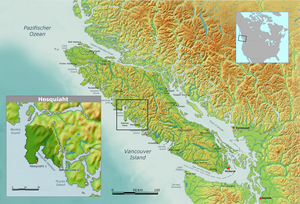Hesquiaht First Nation
This article has multiple issues. Please help improve it or discuss these issues on the talk page. (Learn how and when to remove these messages)
|

The Hesquiaht First Nation (pronounced Hesh-kwit or Hes-kwee-at) is a Nuu-chah-nulth First Nations band government based on the west coast of Vancouver Island in British Columbia, Canada. The Hesquiaht First Nation are members of the Nuu-chah-nulth Tribal Council. Its members are Hesquiaht people.

Hesquiaht is the most northern and isolated of the five Central Region Nuu-chah-nulth Nations. Two of eight Hesquiaht Reserves are occupied by Hesquiaht members— one at Hot Springs Cove and the other at Hesquiaht Harbour. Hot Springs Cove is named after the natural hot springs located at the south end of a narrow peninsula on the east side of the cove. The Reserve Community of Hot Springs (Refuge Cove) village is located on the cove’s west side, home to approximately 80 individuals and 25 families (39 dwellings).
Approximately 100 people live in Hot Springs Cove, with a commute of over one hour by boat into Tofino. The Hot Springs Cove reserve is located on territory claimed by the Ahousaht First Nation.
History
Prior to the 19th century, the Hesquiaht were a congregation of five nations living around Hesquiaht Harbour, with a total population of about 6,000 to 10,000 individuals. Each nation was governed by their respective Ha’wiih (hereditary) system. After the smallpox epidemic, the communities moved to one site at Hesquiaht Village, before being moved by Indian Affairs to the current site at Hot Springs Cove.
The community had to rebuild after a tsunami in 1964. the tsunami heavily damaged the village and forced many people to move away.
The Hesquiaht were affected by the 1990s economic collapse of their traditional fishery and forestry activities.
Governance
The Ha’wiih system functions in Hesquiaht. Four hereditary chiefs guide the community and inform the work of council. The chiefs sit hierarchically, matching the four fingers of the hand. The Ha'wiih are:
- Kathleen Andrews-Thomas - Ta'hii (Head Hereditary Chief) (Middle finger), House of Kaaeth Klaahish Takuumth (includes the Charleson, Ignace and Mickey families)
- Vince Ambrose (ring finger) (Ambrose, Lucas families)
- Steve Tom (index finger) (Tom, Sabbas, Webster families)
- Eddie Jones (small finger) (Jones, Lucas and Ginger families)
Klukwana (the traditional governance system) includes the continued existence of Tikawiilth, those who manage the nation’s affairs on behalf of the hereditary chiefs. The Tikawiilth traditionally manage the affairs of the hereditary chiefs, which in modern times often coincides with the role of Chief and Council. The current Tikawiilth are Pat Charleson (Head Wolf Chief) - (thumb), Larry Paul, Remi Charleson, Eugene August and Chancellor Amos.
Council
Hesquiaht Council is elected every four years. Chief and Council meet monthly, and a joint Chief and Council, membership, and the Hereditary Chiefs meeting is held yearly. The Chief and Council are responsible for management of band affairs. The Chief and Council and their portfolios include:
- Joshua Charleson, Chief Councillor:
- April Charleson, Councillor:
- Constant Charleson, Councillor:
- Linus Lucas Jr., Councillor:
- Joy Charleson, Councillor:
- Preston Campbell, Councillor:
- Kayla Lucas, Councillor
The Hesquiaht Chief and Council rely on administrators to conduct the day-to-day management of tribal affairs, program delivery, and coordination with government agencies.
Diet
The Hesquiaht traditionally use the berries of Vaccinium myrtilloides to make pies and preserves.[1] They use the berries of Vaccinium vitis-idaea ssp as food.[2]
Economic development
Fisheries are an important source of employment. The Nation operated a boat building yard.
The Hesquiaht are an isolated community in the Clayoquot region. Sustainable transportation, community infrastructure, sustainable energy production and keeping or re-attracting members to the community are issues affecting their future.
Hesquiaht are working on developing community resources. This includes eco-tourism, infrastructure and housing, treaty negotiations, and the marketing of the community and territory.
References
- ^ Turner, Nancy J. and Barbara S. Efrat, 1982, Ethnobotany of the Hesquiat Indians of Vancouver Island, Victoria. British Columbia Provincial Museum, page 67
- ^ Compton, Brian Douglas, 1993, Upper North Wakashan and Southern Tsimshian Ethnobotany: The Knowledge and Usage of Plants..., Ph.D. Dissertation, University of British Columbia, page 101
Sources
- Ecotrust Canada. "The Hesquiaht Nation," in Daniel Arbour, Brenda Kuecks & Danielle Edwards (editors). Nuu-chah-nulth Central Region First Nations Governance Structures 2007/2008, Vancouver, September 2008.
